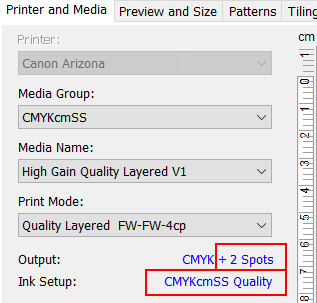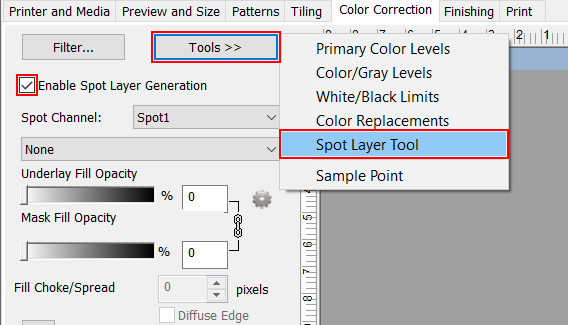

The Spot Layer Tool can be used to set up two spot data planes that define areas where Spot 1 and Spot 2 data are added to a print job. The tool is used with the Arizona printers that both have two extra channels to provide varnish or white ink as well as with CMYK only printers. Both white ink and varnish can be printed using either Spot 1 or Spot 2 data. The same spot data can be used to print either white ink, varnish, or both.
Varnish is not supported for the Arizona 6100 XTHF Mark II series.
In this section, you’ll learn how to access and set up the Spot Layer Tool. The tool provides a variety of options for generation of spot layers, and you may want to explore them with a sample file of your own to familiarize yourself with the functionality. Remember that any actions you set for this tool will only work successfully when used in conjunction with properly constructed layers. The tool is located in the Job Editor on the Color Correction tab.
The Spot Layer Tool provides options for generating spot layers for your image in ONYX Thrive rather than in image editing programs such as Illustrator or Photoshop. The tool has many advanced options and this section will explain them so that you can set them up to best achieve your desired results. The tool options and settings to use it for spot data creation are listed here and are followed by instructions to access the tool.
Open a print job in Job Editor using an ONYX profile (media model) that contains spot data channels.

Select the Color Corrections tab.
Click on Tools and select Spot Layer Tool. This will open the feature set.
Check Enable Spot Layer Generation to activate the tool.

If the Enable checkbox won't activate, the media you used to open the job has not been configured with the Quality-Layered print mode. Create or Edit your media to support spot ink in Media Manager before you open the job in theJob Editor (or download a white ink media model from the website).
Select the spot channel you will use to create data, then use the explanations of the Spot Layer Tool options at the beginning of this section to help you use the tool.

The Spot Layer Tool Provides These Options:
Generation Options - Set Media
Set media color is optional and serves two purposes:
If you want to preview the media color in theJob Editor, you can set the media color either from the image or from the color dialog menu.
If you have areas in your image that use the media color and you want that color to be handled with special consideration. For example; if you want the media color from the image to show through the design, you must first define your fill options, then set the media color and define the Media Color Handling Options as either "Spot Knockout" or "Full Knockout".
The generation options are used in combination with the fill options, except when the media color handling is set to "No Knockout". If you want to use the Spot Layer Tool to create flood fills, underlay fills or mask fills it is not always necessary to set a mask or media color to get the desired results.
To set the media color: Click the sample box to activate the color picker or use the drop down arrow to access the Color Dialog menu.
Generation Options - Set Mask
The mask allows you to determine the area that you wish to print with spot data. Setting the mask color is optional. If the image you are printing contains white data in more than the mask area, you will need to set up a different background color not used anywhere else in the file to use as your mask. This must be done in an image-editing program prior to bringing the image into the Spot Layer Tool.
To set the mask color: Click the sample box to activate the color picker or use the drop-down arrow to pick the color from the preview.
Generation Options - Media Color Handling
If you have set a media color, you have three options for how you would like the media color to be handled. The term “Knockout” means to remove from the selection. If you’ve set a media color, chances are you want some portion of the design to be removed to use the media color. These are the option you have to choose from:
No Knockout - If you’ve set a media color to help you visualize your output, choose this option. This will print the image and spot data with no knockout.
Spot Knockout - If you choose this option, RIP-Queue removes the spot data anywhere the image data matches the media color that you set. Use this option when you want to knockout the spot data but still print the image data that matches the media color.
Full Knockout - If you choose this option, RIP-Queue removes the spot data and the image data anywhere the image data matches the media color that you set. Use this option when you want to knockout the spot data and the image data, allowing the media to fully show through.
Spot Channel
The Arizona 6100 XTHF Mark II series has two spot channels available. The names that appear here should be the ones you used to create the media in Media Manager. The recommended spot channel names are: "Spot 1" and "Spot 2".
ONYX software treats Spot 1 and Spot1 as equivalent. The space between "t" and "1" is not important but the case is, so the "S" must always be capitalized.
Flood Fill
This option generates a flood fill for the entire image by combining the underlay and mask fills together. When you check this option, the underlay and mask fill sliders lock together and are set at 100%. You can change the opacity for the flood fill by moving either of the sliders.
Underlay Fill Opacity
This option generates a fill in the selected spot channel where image data exists. The fill will be generated anywhere image data does not match the mask.
Mask Fill Opacity
This option generates a fill in the selected spot channel where mask data exists. The fill will be generated anywhere the image data matches the mask color.
Choke and Spread
Choke reduces the outer edge of the underlay. Use choke when you want to eliminate white from peeking out of the edge of your image. Spread increases the outer edge of the underlay fill. Use spread when you want a deliberate halo around the edge of your image. Choke and Spread work in tandem. Each mark on the slider represents 1 pixel width of choke or spread up to 10 pixels (+-) .The actual preview in the Job Editor is exaggerated from what is printed. This exaggerated display makes it easier for you to see the results from moving the slider. When you use the Spot Layer Tool for masks, we recommend a choke value of 3 ticks.
Diffuse Edge
Use this option when you want a gradual transition from the underlay to the mask to create a soft edge for the fill. We do not recommend use of this option.
Filter
Once you’ve defined your settings, save them by exporting a Filter to use on similar jobs. Filters are a global color correction that can be applied to Quick Sets to automate the printing process for multiple jobs that use the same settings.
Many of the Quick Set and Filter settings for a job can be overridden in RIP-Queue or Job Editor, if desired.